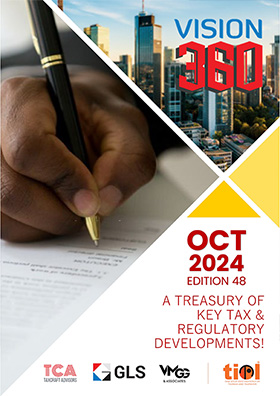By TIOL News Service
 PARIS, APR 03, 2016: TAX revenues in African countries are rising as a proportion of national incomes, according to the inaugural edition of Revenue Statistics in Africa. The report, which contains internationally comparable revenue data for eight African countries, accounting for almost a quarter of Africa’s total GDP, will be discussed today in Addis Ababa during the 2016 African Union (AU) – Economic Commission for Africa (ECA) Conference of Ministers.
PARIS, APR 03, 2016: TAX revenues in African countries are rising as a proportion of national incomes, according to the inaugural edition of Revenue Statistics in Africa. The report, which contains internationally comparable revenue data for eight African countries, accounting for almost a quarter of Africa’s total GDP, will be discussed today in Addis Ababa during the 2016 African Union (AU) – Economic Commission for Africa (ECA) Conference of Ministers.
In 2014, the eight countries covered by the report - Cameroon, Côte d’Ivoire, Mauritius, Morocco, Rwanda, Senegal, South Africa and Tunisia - reported tax revenues as a percentage of GDP ranging from 16.1% to 31.3%. Since 2000, all of these countries experienced increases in their tax-to-GDP ratios. The size of these increases ranged from 0.9 percentage points in Mauritius to 6.7 percentage points in Tunisia. Morocco, Rwanda and South Africa had increases of around 5 to 6 percentage points. In comparison, the OECD average of 34.4% was only 0.2 percentage points higher in 2014 than in 2000.
Revenue Statistics in Africa is produced jointly by the African Tax Administration Forum (ATAF), the African Union Commission (AUC), the Organisation for Economic Co-operation and Development (OECD) and the OECD Development Centre. The data has been assembled and presented in close collaboration with the governments of the participating countries. The report was conceived as part of the AUC’s Agenda 2063, which aims to “develop and implement frameworks for Policies on Revenue Statistics and Fiscal Inclusiveness for Africa.”
The increases in tax revenues in African countries reflect continuing efforts to mobilise domestic resources, as well as the result of tax reforms and modernisation of tax systems and administrations.
The biggest driver of tax increases since 2000 in countries covered by the report has been rising taxes on income and profits, and more specifically increases in corporate income tax revenue. There were also substantial increases in Value Added Tax (VAT) revenues.
Some African countries are significantly dependent on non-tax revenues, and more specifically on grants such as foreign aid and resource rents together with other property income. The countries with the lowest national incomes covered by the report had relatively higher non-tax revenues, which tend to be more volatile than tax revenues, making their finances less stable and predictable.
A special chapter in the report describes the benefits and limitations of collecting comparable data and how these issues relate to Africa. The new database responds to a demand from governments, citizens and policy makers for reliable and comparable revenue data to inform fiscal policy and provide a basis for the implementation of future reforms. The eight African countries covered by the new report will be added to the existing Revenue Statistics databases, which now cover 66 countries worldwide, allowing for greater international comparison, policy dialogue and cooperation between countries in Africa, Asia, Latin America and the Caribbean and the OECD.
Key findings
Tax to GDP ratios
· In 2014, the tax-to-GDP ratios in the eight African countries covered ranged from 16.1% to 31.3% (the OECD average is 34.4%).
· Tunisia had the highest tax-to-GDP ratio in 2014 (31.3%), followed by Morocco (28.5%).
· Cameroon and Rwanda had the lowest tax-to-GDP ratios in 2014, at 16.1%, followed by Côte d’Ivoire (17.8%).
· All eight countries saw increasing tax-to-GDP ratios over the 2000-14 period. These increases ranged from 0.9 percentage points in Mauritius to 6.7 percentage points in Tunisia. Morocco, Rwanda and South Africa had increases of around 5-6 percentage points.
Tax structure
· The share of taxes on incomes and profits in total tax revenues is highest in South Africa, at 51.2 % in 2014. The share of personal income taxes in South Africa is higher than the OECD average, whereas it is lower for the other participating African countries.
· The shares of corporate income tax revenue to total tax revenues were significantly higher than the 8.5% OECD average. In six of the eight African countries these shares ranged between 13% and 18%.
· Consumption taxes yielded the largest share of the total tax revenue – over 55% - in Cameroon, Côte d’Ivoire, Mauritius, Rwanda and Senegal. With the exception of Côte d’Ivoire, more than half of this category of revenue is generated by VAT.
· Tunisia and Morocco displayed a more evenly spread tax mix compared with the other countries: around 30% of tax revenues came from taxes on incomes and profits; around 35% to 40% was from consumption taxes; and 20% to 28% was from social security contributions. The share of social security contributions to total tax revenue is far smaller in the six Sub-Saharan countries, ranging from 1.5% in South Africa to 11.3% in Côte d’Ivoire.
Non-tax revenues
· The total non-tax revenues collected as a percentage of GDP in 2014 ranged from 0.6% of GDP in South Africa to 9.5% of GDP in Rwanda.









 PARIS, APR 03, 2016: TAX revenues in African countries are rising as a proportion of national incomes, according to the inaugural edition of Revenue Statistics in Africa. The report, which contains internationally comparable revenue data for eight African countries, accounting for almost a quarter of Africa’s total GDP, will be discussed today in Addis Ababa during the 2016 African Union (AU) – Economic Commission for Africa (ECA) Conference of Ministers.
PARIS, APR 03, 2016: TAX revenues in African countries are rising as a proportion of national incomes, according to the inaugural edition of Revenue Statistics in Africa. The report, which contains internationally comparable revenue data for eight African countries, accounting for almost a quarter of Africa’s total GDP, will be discussed today in Addis Ababa during the 2016 African Union (AU) – Economic Commission for Africa (ECA) Conference of Ministers.




